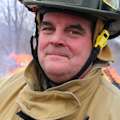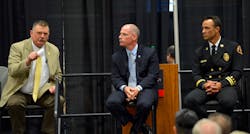Find full coverage of Firehouse World in San Diego this week on Firehouse.com and also on Twitter and Facebook.
SAN DIEGO – It was East Coast versus the West Coast as two experienced and well respected battalion fire chiefs squared off for a Firehouse World moderated discussion entitled “Tactics & Training for the Modern Fire Ground.”
John Salka, battalion chief FDNY retired and Derek Alkonis, battalion chief County of Los Angeles Fire Department participated in session moderated by Tim Sendelbach, editor in chief of “Firehouse” and Firehouse World director.
Fielding pointed questions from conference attendees from the show floor, Salka and Alkonis shared views that were both opposing and complimentary on topics ranging from firefighter safety to the latest studies from
Underwriters Laboratories and the National Institute of Standards and Technology.
“If your life depended on that you know, wouldn’t you want to know it all,” Alkonis challenged the dozens of attendees who were seated right in the middle of all the action on the show floor.
Alkonis said line of duty deaths and severe injury reports involving firefighters, generated by the National Institute for Occupational Safety and Health (NIOSH) are valuable training tools that can help keep firefighters safe.
“We almost need to do a cut and paste from the NIOSH reports that will show what they (firefighters) failed to do,” Alkonis said.
Salka agreed and said the 80 or 90 NIOSH reports involving line of duty deaths generated annual all have good information.
“Every one of them should be a lesson learned,” said Salka.
Sendelbach said information is important, but not always immediately embraced. He said when the National Fire Protection Association first introduced the 1500 “Standard on Fire Department Occupational Safety” in 1992, it was shunned by the fire service.
“But look at it now, it’s almost a religious document,” Sendelbach said, adding that many departments use it to justify equipment purchases and expenses.
Alkonis said it’s natural for the fire service personnel to have some level of push back for new items and ideas, but, they should not be summarily dismissed in the name of tradition.
He said there was a time when the “softening” of a fire building was customary, but that’s not the case any longer. He said there was a day when firefighters would take every window and every door to ventilate and provide ways out of the building for interior firefighters.
Things are different today Alkonis said, noting that firefighters are being taught to “be cognizant of flow path,” and be a little more judicious with venting and opening doors. After a 360 degree view of the buildings has been completed, and a grasp of the fire has been determined, then there can be a coordinated effort for breaking windows and opening doors.
Salka amplified the need for understanding ventilation and the importance of keeping doors closed to control the flow path.
Salka said breaking a window on the second floor in a residential fire is significantly different than breaking a second floor window of a four-story commercial building.
A fire on the first floor could quickly be pulled up the stairs and into the kid’s bedroom with an open door, Salka said, whereas there is little chance of a fire in a first floor butcher shop spreading to the second floor apartment just because of a broken window on the second floor.
“You have to know what kind of building you’re dealing with,” Salka said.
Sendelbach said training has evolved from the days when a RIT team staged a truck load of equipment on the front lawn of at a fire scene.
“How many firefighters run into a burning building with airbags these days,” Sendelbach asked. Not one hand was raised. “Thank you very much.” He said the guidelines have changed significantly since the first day of rapid intervention teams being deployed.
Alkonis advocated more cognitive learning that supplements the hands on training.
“Don’t get me wrong, I encourage all hands on training, but there has to be some cognitive learning,” Alkonis said. “It’s the cognitive part that lets me use my hands to fix the condition.”
Salka said there’s a fair amount of on the job training that goes on in the fire service and he said there should be an opportunity to learn at every fire. He said firefighters always need to bring their A game to the fire and prevent injury and property loss, but they shouldn’t ignore the opportunities to learn.
“There’s no such thing as a perfect fire,” Salka said. “If you think you’ve had one you’re full of crap. We all make little mistakes here and there.” He added that he was always told to “never waste a fire” and always use them to learn.
There was a fair amount of discussion about the science of fire and the fact that many old technics and thoughts are once again new.
Alkonis said firefighters need to have information and training to make the right decisions when it matters most and to not get hung up on catch phrases or mantras that don’t necessarily make sense any longer.
Salka, on the other hand said he always questions why a technique is being changed.
“I question changes,” Salka said. “I want to know what we’re fixing before I make a change. I want to know why we need to do things differently. What is the problem we are fixing?”
Alkonis said it’s time to start teaching the principals of fire science and taking a look at the reports and the information UL and NIST are sharing.
“We need to look how we apply it to make it better,” Alkonis said.
Salka was a little more circumspect about the new information and the science. He said it is easy to create results when all the variables are controlled. A real life fire is completely different than a laboratory fire and a firefighter “from Mayberry Volunteer Fire Department” at 2 a.m. is not a scientist able to apply water and control ventilation perfectly.
“If I controlled the study, I bet I could get very different results,” Salka said.
Alkonis said they very nature of science to create a hypothesis and then set to prove it.
Running out of time Sendelbach said it’s not possible to change the principals of science, but the debate and application will continue into the future. He said attendees will have to wait until next year for a resolution to the cliff hanger.
“Stay tuned to next year,” Sendelbach said.
Full Coverage of Firehouse World:
- Photos: Hands-on Training
- Science Needs to Be Incorporated in Modern Firefighting
- Competent Command Essential at Incidents
- Innovative Apparatus on The Show Floor
- Firefighters Face New Challenges Daily
- Eisner Remember, Change Discussed at Firehouse World Opening
- Photos: Day 2 of Firehouse World
- A West Coast Versus East Coast Debate
About the Author

Ed Ballam
Ed Ballam served as associate editor for Firehouse. He is the assistant chief of the Haverhill Corner, N.H. Fire Department, and a National Registered EMT. He is also a Deputy Forest Fire Warden for the New Hampshire Division of Forests and Lands. Professionally, he's been a journalist for over 35 years working for a variety of publications, including employment as managing editor of a national fire service trade journal for more than a decade.
